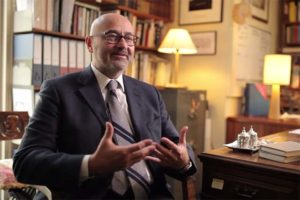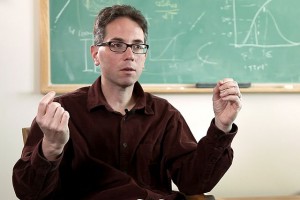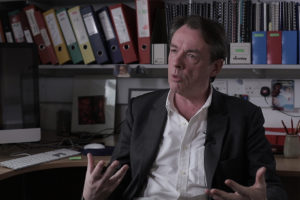Dante’s Heaven
Alessandro Scafi on Divine Comedy story line, the desire of God, and Mark Twain
The story of particle physics started in the late 19th century when the electron was discovered in 1897. That was followed a few years later when Einstein, in 1905, in order to understand the photoelectric effect of the way in which light interacts with matter, postulated the reality of a quantum of light that we call the photon. That was the beginning of particle physics back around the beginning of the last century. Since then, we’ve discovered many other types of particles. We have now, based on our knowledge of those particles, a description of all the visible matter in the Universe. For example, in the 1980s, we discovered the particles responsible for many of the interactions between those particles, and in 2012, we discovered the Higgs boson, which was the last particle expected in the Standard Model. The Standard Model works incredibly well to describe all the visible matter in the Universe, but it leaves many questions open and not understood. One of the possible theories for addressing those is a theory called supersymmetry, which I’ll come back to later on.
Many other discoveries in particle physics were made using cosmic rays, which are energetic particles that bombard the Earth all the time. They were discovered first by physicists going up on balloons; we discovered this ionizing radiation, and then later on, people started to see the showers of particles produced by this radiation. They discovered, for example, antimatter, and they discovered that in parallel to the electron, there was a heavier particle, much like the electron but 200 times heavier, called the muon. Other particles were also discovered in cosmic rays in the 1930s, 1940s and 1950s: for example, things that we call strange particles, so the particles that behaved in an unexpected way lived much longer than we had expected. We now know that that’s because they contain another type of quark.
So the constituents of matter are the quarks on the one hand, the electron, the muon (actually, there’s a third electron-like particle), and there are also things called neutrinos. Neutrinos are very light neutral particles which are linked together to the electron, muon and so on. They are emitted in the form of radioactivity. For example, the neutron is an unstable particle and decays into the proton and electron and a neutrino. So, the matter particles are the quarks, the electron-like particles and the neutrinos. Between these particles of matter, we have four different types of interaction, so we have gravity, we have electromagnetism (that’s a unified theory of electricity and magnetism that was actually constructed by James Clerk Maxwell here in King’s College London just over 150 years ago) and then at the level of particles we have two other types of interaction: we have a strong force that holds quarks together inside protons, protons and neutrons together inside nuclei, and we have a weak force responsible for forms of radioactive decay, for example, emitting neutrinos.
So, let me describe a little bit more about how the properties of the Standard Model particles were established and how the Standard Model itself was verified. In the 1980s, we discovered the particles responsible for the weak interactions. Those are particles that weigh something like 90 times as much as a proton, so although they’re, in some sense very small particles, they’re very heavy, and one of the big puzzles is why they are so heavy. That was in the 1980s. In the 1990s, experiments at CERN and other big particle physics laboratories verified the predictions of the Standard Model in great detail. You can say that by around 2000, the two top lines on the pullover had been checked with extremely high precision: many of the predictions of the Standard Model had been verified with an accuracy of a fraction of a per cent.
But there was still something missing in the year 2000, and what was missing was an explanation of where the particle masses came from. By doing the very detailed measurements of the Standard Model particles, we could be sure that there had to be something, but whether it was really the Higgs or not was not established until 2012.
So the Higgs boson was discovered in 2012 and you might say, okay, the Standard Model finished, you can all go home, but there’s many puzzles outstanding that we need to try to understand. For example, why there are so many different types of a fundamental particle? We know that there are six quarks but why? We know that there are three neutrinos but why?
We don’t have an explanation within the Standard Model of the dark matter that astronomers discovered to have a much larger density in the Universe today than the particles described by the Standard Model. We don’t understand where the matter in the Universe originated.
There are all sorts of theoretical ideas that would help us to understand what we see in the Standard Model and what may lie beyond it. My own favourite idea amongst those is the theory called supersymmetry. So what supersymmetry says is that in addition to all the known established particles in the Standard Model, there must be a bunch of partner particles which have, for example, the same electric charge, but they’re much heavier, and they spin at different rates. I should explain that all elementary particles can be thought of like ballerinas doing pirouettes, and some of them pirouette fast, some of them slow. Supersymmetry says that there are partnerships between the slow-moving and the fast-pirouetting elementary particles. It’s a beautiful theory. It’s useful for lots of things: it could help us unify all the fundamental forces, it could help us provide a quantum theory of gravity, and it could provide dark matter. So, my heart belongs to the supersymmetry, but at the moment, there’s no evidence for supersymmetry. We’ve got a theory, the Standard Model, which works fantastically well. We know it must be incomplete, and supersymmetry is just one of the ideas. We’re looking to future experiments, for example, with a Large Hadron Collider at CERN hopefully to find something else to put on the pullover.

Alessandro Scafi on Divine Comedy story line, the desire of God, and Mark Twain

Astrophysicist Joshua Winn on astronomical transits, the importance of liquid water, and Kepler mission

Biogerontologist David Gems on the innate plasticity in aging, senolytic drugs and whether we should expect dr...